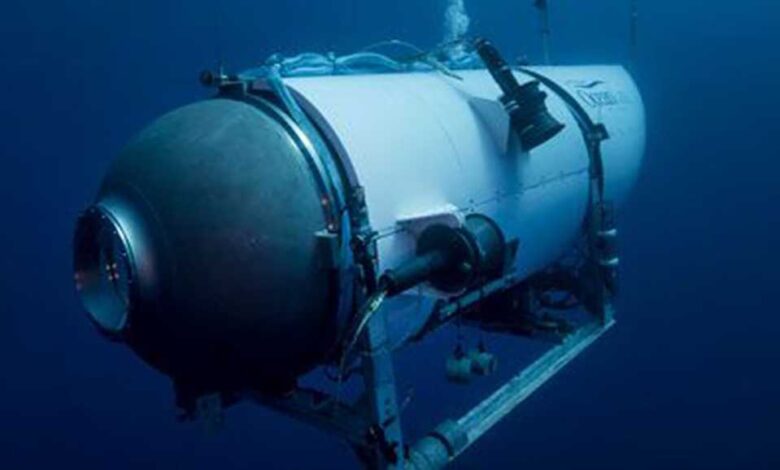

A submersible carrying five people to see the remains of the Titanic at the bottom of the North Atlantic Ocean is still missing despite a massive search operation – but banging sounds were reportedly heard in the area Tuesday as time runs out.Search teams heard the sounds in 30-minute intervals Tuesday, according to an internal government memo update on the search. Banging was still heard four hours later, after additional sonar devices were deployed.A subsequent update sent Tuesday night suggested more sounds were heard, though it was not described as “banging.” Still, it indicates “continued hope of survivors,” the update said.CNN has reached out to OceanGate, the US Coast Guard in Boston and Canadian authorities for comment. Rolling Stone was first to report the news Tuesday night.The Titan submersible had been on its way to the famous wreckage, off the coast of St John’s, Newfoundland, in Canada, when it lost contact with its support ship, leaving the people on board with only enough oxygen for a few days.Here's what we know so far:How did they go missing?The submersible was part of an eight-day journey conducted by OceanGate Expeditions. The trip is based out of Newfoundland, with participants first traveling 400 nautical miles to the wreck site, which is about 900 miles off the coast of Cape Cod, Massachusetts. The submersible began its two-hour descent to the wreck on Sunday morning. It lost contact with the Polar Prince, the support ship that transported the vessel to the site, 1 hour and 45 minutes into its descent, officials said. Search operations began later that day.It’s still not clear what happened to the submersible, why it lost contact, and how close to the Titanic it was when it went missing.Who's on board?The five people on board include one pilot and four “mission specialists,” said Rear Adm. John Mauger, commander of the U.S. Coast Guard’s First District.OceanGate CEO and founder Stockton Rush is among those onboard, according to a source with knowledge of the mission plan.A British businessman based in the United Arab Emirates, Hamish Harding, is also onboard, according to a social media post by the company he owns, Action Aviation.“The sub had a successful launch and Hamish is currently diving,” the company said in an Instagram post on Sunday.Harding was one of the first people to travel the Challenger Deep in the Pacific Ocean – the deepest known point on Earth.On Saturday he wrote of the Titanic mission: “I am proud to finally announce that I joined OceanGate Expeditions for their RMS TITANIC Mission as a mission specialist on the sub going down to the Titanic.”Harding had posted on social media Saturday saying that diver Paul-Henri Nargeolet was scheduled to be on Sunday’s dive with him. Nargeolet has led several expeditions to the Titanic and supervised the recovery of many artifacts from the wreck, according to the E/M Group, where Nargeolet was director of underwater research.CNN has attempted to reach out independently to Nargeolet with no success.A Pakistani businessman, Shahzada Dawood, and his son Sulaiman Dawood, were also on board, according to a statement released by the family on Tuesday. Contact has been lost and there is limited information available, it said.Shahzada Dawood is a trustee of the SETI Institute, a research organization in California, according to its website. He is also vice chairman of Dawood Hercules Corporation, part of the Dawood Group, a conglomerate of various businesses owned by the family.Authorities have not publicly identified the passengers on board, and said Monday they are still notifying their families.The OceanGate website says its expeditions, which cost upwards of $250,000, typically involve one pilot, a “content expert” and three paying passengers.How much time do they have?Coast Guard officials estimated on Monday afternoon the submersible had “somewhere between 70 to the full 96 hours” of oxygen – potentially giving rescuers until Friday to locate and retrieve the vessel. On Tuesday, U.S. Coast Guard officials said at a 1 p.m. ET news conference that the submersible has about 40 hours of oxygen left.But there are a number of challenges, including the remote location, local weather conditions, the state of the submersible – and the extraordinary depth of the ocean in the area they went missing.The deepest ever underwater rescue was that of Roger Chapman and Roger Mallinson, who were rescued from the Pisces III submersible at depths of 1,575 feet in 1973. They were trapped for 76 hours before finally being hauled to the surface.The Titanic wreckage is much deeper, sitting nearly 13,000 feet below sea level. It’s not clear how deep the submersible is. Some experts have pointed out it might be near the surface, since submersibles typically are able to shed weight for additional buoyancy. But even if they reach the surface, the door is bolted from the outside – meaning they still risk running out of oxygen unless they are located and freed by rescuers.What is the submersible? What’s it like inside?A submersible is different from a submarine in a few key ways. It has limited power reserves, so it needs a support ship on the surface to launch and recover it. It can’t stay underwater for as long; the Titan typically spends 10 to 11 hours during each dive to the Titanic wreck, compared to submarines that can stay underwater for months.The Titan is made of carbon fiber and titanium, weighing 23,000 pounds, with safety features to monitor the structure integrity of the vessel, according to OceanGate.It’s also small and sparse on the inside, with about as much space as a minivan, according to CBS correspondent David Pogue, who took a trip on the Titan down to the Titanic wreck last year. There is only one toilet, and no seats; passengers sit cross legged on the floor. There are no windows except the porthole through which passengers view the Titanic.With no GPS underwater, the submersible is only guided by text messages from the surface ship. On Pogue’s trip, communications broke down during a dive and the submersible was lost for over two hours, he said.The pilot steers the sub using a video game controller – but if that fails, a hard-wired system can control the propellers, according to Aaron Newman, who took the dive on the Titan in 2021 and is now an OceanGate investor. Thrusters are powered by an external electrical system, while an internal system powers communications and a heater, he said. What search operations are underway? How might it be rescued?Multiple agencies from both the US and Canada are involved in the search, looking both on the surface and underwater. More than 10,000 square miles have been searched as of Tuesday.Boats, aircraft and radar equipment are scanning above water in case the submersible had surfaced. Sonar buoys and sonar equipment on ships are also being used to detect sounds below water.The US Coast Guard, US Navy, US Air Force, Canadian Coast Guard, and Canadian military are all coordinating the search and potential rescue operations. France has also sent a research ship, equipped with an underwater robot, to join the search.Deep sea-mapping company Magellan, most famously known for its one-of-a-kind deep sea imagery of the Titanic, is also working to get its equipment to the site.But finding the submersible is just the first step; rescuing it could be a whole other challenge.Depending where and at what depth the submersible is found, there could be limited options for rescue vessels.For instance, the US Navy’s nuclear-powered submarines usually operate at 800 feet or less – meaning they can’t dive down to the ocean floor, where water pressure on the submarine hull could make it implode.During the 1973 rescue, authorities used other submersibles and a remotely operated, Navy-developed recovery vessel to attach lines to the Pisces III – which were then used to pull it back to the surface.It’s not clear whether these methods could work for the Titan, given the uncertainty around its location.Have there been safety concerns before?The incident has prompted discussion around the safety of deep-sea tourism, with some pointing out that OceanGate has come under criticism before.Two former OceanGate employees separately brought up similar safety concerns about the thickness of the Titan’s hull when they were employed by the company years ago.A statement from a research lab also appears to show conflicting information about the engineering and testing that went into the development of the vessel.OceanGate’s legal representative boasted the Titan’s “unparalleled” safety features in a 2021 court filing, saying it had been built with the University of Washington’s Applied Physics Laboratory – but the university said the lab had never dealt with the design, engineering or testing of the Titan.Industry leaders also expressed concerns five years ago about the company’s “experimental approach” to the Titan submersible and its trip to the Titanic, the New York Times reported Tuesday.The Manned Underwater Vehicles committee of the Marine Technology Society said it penned a letter to Rush, the missing CEO, in 2018. The group warned of potential “negative outcomes (from minor to catastrophic) that would have serious consequences for everyone in the industry,” said the letter obtained by the Times.OceanGate has not responded to a request for comment on the letter, or on the two former employees’ claims.
A submersible carrying five people to see the remains of the Titanic at the bottom of the North Atlantic Ocean is still missing despite a massive search operation – but banging sounds were reportedly heard in the area Tuesday as time runs out.
Search teams heard the sounds in 30-minute intervals Tuesday, according to an internal government memo update on the search. Banging was still heard four hours later, after additional sonar devices were deployed.
A subsequent update sent Tuesday night suggested more sounds were heard, though it was not described as “banging.” Still, it indicates “continued hope of survivors,” the update said.
CNN has reached out to OceanGate, the US Coast Guard in Boston and Canadian authorities for comment. Rolling Stone was first to report the news Tuesday night.
The Titan submersible had been on its way to the famous wreckage, off the coast of St John’s, Newfoundland, in Canada, when it lost contact with its support ship, leaving the people on board with only enough oxygen for a few days.
Here's what we know so far:
How did they go missing?
The submersible was part of an eight-day journey conducted by OceanGate Expeditions. The trip is based out of Newfoundland, with participants first traveling 400 nautical miles to the wreck site, which is about 900 miles off the coast of Cape Cod, Massachusetts.
The submersible began its two-hour descent to the wreck on Sunday morning. It lost contact with the Polar Prince, the support ship that transported the vessel to the site, 1 hour and 45 minutes into its descent, officials said.
Search operations began later that day.
It’s still not clear what happened to the submersible, why it lost contact, and how close to the Titanic it was when it went missing.
Who's on board?
The five people on board include one pilot and four “mission specialists,” said Rear Adm. John Mauger, commander of the U.S. Coast Guard’s First District.
OceanGate CEO and founder Stockton Rush is among those onboard, according to a source with knowledge of the mission plan.
A British businessman based in the United Arab Emirates, Hamish Harding, is also onboard, according to a social media post by the company he owns, Action Aviation.
“The sub had a successful launch and Hamish is currently diving,” the company said in an Instagram post on Sunday.
Harding was one of the first people to travel the Challenger Deep in the Pacific Ocean – the deepest known point on Earth.
On Saturday he wrote of the Titanic mission: “I am proud to finally announce that I joined OceanGate Expeditions for their RMS TITANIC Mission as a mission specialist on the sub going down to the Titanic.”
Harding had posted on social media Saturday saying that diver Paul-Henri Nargeolet was scheduled to be on Sunday’s dive with him. Nargeolet has led several expeditions to the Titanic and supervised the recovery of many artifacts from the wreck, according to the E/M Group, where Nargeolet was director of underwater research.
CNN has attempted to reach out independently to Nargeolet with no success.
A Pakistani businessman, Shahzada Dawood, and his son Sulaiman Dawood, were also on board, according to a statement released by the family on Tuesday. Contact has been lost and there is limited information available, it said.
Shahzada Dawood is a trustee of the SETI Institute, a research organization in California, according to its website. He is also vice chairman of Dawood Hercules Corporation, part of the Dawood Group, a conglomerate of various businesses owned by the family.
Authorities have not publicly identified the passengers on board, and said Monday they are still notifying their families.
The OceanGate website says its expeditions, which cost upwards of $250,000, typically involve one pilot, a “content expert” and three paying passengers.
How much time do they have?
Coast Guard officials estimated on Monday afternoon the submersible had “somewhere between 70 to the full 96 hours” of oxygen – potentially giving rescuers until Friday to locate and retrieve the vessel.
On Tuesday, U.S. Coast Guard officials said at a 1 p.m. ET news conference that the submersible has about 40 hours of oxygen left.
But there are a number of challenges, including the remote location, local weather conditions, the state of the submersible – and the extraordinary depth of the ocean in the area they went missing.
The deepest ever underwater rescue was that of Roger Chapman and Roger Mallinson, who were rescued from the Pisces III submersible at depths of 1,575 feet in 1973. They were trapped for 76 hours before finally being hauled to the surface.
The Titanic wreckage is much deeper, sitting nearly 13,000 feet below sea level.
What is the submersible? What’s it like inside?
A submersible is different from a submarine in a few key ways. It has limited power reserves, so it needs a support ship on the surface to launch and recover it. It can’t stay underwater for as long; the Titan typically spends 10 to 11 hours during each dive to the Titanic wreck, compared to submarines that can stay underwater for months.
The Titan is made of carbon fiber and titanium, weighing 23,000 pounds, with safety features to monitor the structure integrity of the vessel, according to OceanGate.
It’s also small and sparse on the inside, with about as much space as a minivan, according to CBS correspondent David Pogue, who took a trip on the Titan down to the Titanic wreck last year. There is only one toilet, and no seats; passengers sit cross legged on the floor. There are no windows except the porthole through which passengers view the Titanic.
With no GPS underwater, the submersible is only guided by text messages from the surface ship. On Pogue’s trip, communications broke down during a dive and the submersible was lost for over two hours, he said.
The pilot steers the sub using a video game controller – but if that fails, a hard-wired system can control the propellers, according to Aaron Newman, who took the dive on the Titan in 2021 and is now an OceanGate investor. Thrusters are powered by an external electrical system, while an internal system powers communications and a heater, he said.
What search operations are underway? How might it be rescued?
Multiple agencies from both the US and Canada are involved in the search, looking both on the surface and underwater. More than 10,000 square miles have been searched as of Tuesday.
Boats, aircraft and radar equipment are scanning above water in case the submersible had surfaced. Sonar buoys and sonar equipment on ships are also being used to detect sounds below water.
The US Coast Guard, US Navy, US Air Force, Canadian Coast Guard, and Canadian military are all coordinating the search and potential rescue operations. France has also sent a research ship, equipped with an underwater robot, to join the search.
Deep sea-mapping company Magellan, most famously known for its one-of-a-kind deep sea imagery of the Titanic, is also working to get its equipment to the site.
But finding the submersible is just the first step; rescuing it could be a whole other challenge.
Depending where and at what depth the submersible is found, there could be limited options for rescue vessels.
For instance, the US Navy’s nuclear-powered submarines usually operate at 800 feet or less – meaning they can’t dive down to the ocean floor, where water pressure on the submarine hull could make it implode.
During the 1973 rescue, authorities used other submersibles and a remotely operated, Navy-developed recovery vessel to attach lines to the Pisces III – which were then used to pull it back to the surface.
It’s not clear whether these methods could work for the Titan, given the uncertainty around its location.
Have there been safety concerns before?
The incident has prompted discussion around the safety of deep-sea tourism, with some pointing out that OceanGate has come under criticism before.
Two former OceanGate employees separately brought up similar safety concerns about the thickness of the Titan’s hull when they were employed by the company years ago.
A statement from a research lab also appears to show conflicting information about the engineering and testing that went into the development of the vessel.
OceanGate’s legal representative boasted the Titan’s “unparalleled” safety features in a 2021 court filing, saying it had been built with the University of Washington’s Applied Physics Laboratory – but the university said the lab had never dealt with the design, engineering or testing of the Titan.
Industry leaders also expressed concerns five years ago about the company’s “experimental approach” to the Titan submersible and its trip to the Titanic, the New York Times reported Tuesday.
The Manned Underwater Vehicles committee of the Marine Technology Society said it penned a letter to Rush, the missing CEO, in 2018. The group warned of potential “negative outcomes (from minor to catastrophic) that would have serious consequences for everyone in the industry,” said the letter obtained by the Times.
OceanGate has not responded to a request for comment on the letter, or on the two former employees’ claims.
Source link







